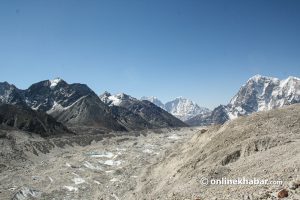Climate change and biodiversity loss are some of the serious threats and sensational topics of today’s world. Among many countries, the landlocked country of Nepal is extremely vulnerable to geological and climate change-related disasters including its impacts on biodiversity.
Nepal is a developing country with unique topography. In terms of biodiversity richness, Nepal is ranked 25th position in the world. However, haphazard development is creating a threat to its biodiversity. Moreover, climate change–along with its other serious impacts including reduced agricultural production, food poverty, strained water resources, loss of forests and biodiversity, and infrastructure damage–is also adversely affecting biodiversity richness in Nepal, forcing the country to explore options to mitigate the effects.
Catastrophes of climate change
In recent years, significant monsoon rains have been experienced by many highland dwellers of Manang in the Himalayan Annapurna Range. This unpredictable monsoon precipitation is a relatively new phenomenon. Some farmers in the highland Mustang claim the changing environment has had a substantial impact on their way of life. They are certain that the climate has changed because they have extensive knowledge of the local ecology.
Some of them have a beneficial influence as they are cultivating new vegetables that previously required greenhouse gases to thrive, such as cauliflower, cabbage, chilli, tomato, and cucumber. Other changes were observed at the local level, such as early flowering and ripening of fruits or crops, as well as altered seasonal weather patterns. New plants that previously exclusively grew at lower elevations have now been discovered at higher elevations. Although some beneficial changes can be seen, they can disturb the whole ecosystem as new plants can affect the endemic floras and fauna.
Between 1977 and 2010, the entire estimated ice reserve in Nepal’s Himalayas dropped by 29%. Each year, the number of glacial lakes and glaciers has increased by 11%. As a result of climate change’s evident and strong effects on snow and glaciers, the glacier lake outburst floods (GLOFs) are projected to rise.
In the lowland area, extreme weather disasters such as landslides, floods, and droughts have become more common in Nepal, resulting in human deaths as well as substantial social and economic costs. At the local level, issues such as unpredictable rainfall patterns, water risks, water scarcity, and vector-borne diseases are also said to be on the rise because of climate change.
Despite its abundant natural resources, the effect of climate change in Nepal is already felt all over the nation and can be predicted to be intensified in the future.
Risk of losing biodiversity richness
The average temperature of Nepal is increasing by 0.056°C/year. The increasing temperature is directly correlated to the rise of atmospheric CO2 leading to the loss of biodiversity that eventually results in its extinction.
Climate change causes variation in temperature and rainfall which leads to a drop in crop production and the growth of invasive species. In recent years, non-native plants have expanded rapidly in Nepal’s oldest national park, and a part of the cause is rising temperatures which is due to fossil fuel use. The shifting climate appears to be favouring the growth of invasive alien plants.
Nepal’s biodiversity is facing a great threat due to an increase in pollution, land-use change, invasive species, direct extraction of medicinal plants, and poaching of animals. Climate change is one of the leading problems which is experienced all over the country especially higher in the high altitudinal area, severely affecting biodiversity.
Mitigation measures

Some cities of Nepal such as Kathmandu are recorded as one of the most polluted cities in Asia. This is caused by rapid urbanisation and various infrastructural developmental projects. The number of vehicles is exponentially increasing, but there is no system of emission checks. Old engine vehicles which emit harmful gases are also widely in practice. So, the Ministry of Transportation should take an action and adopt a long-term program to mitigate it and prevent rapid climate change.
Nepal is one of the richest countries in freshwater (based on glaciers, snowmelt, and rainfall, which account for 2.27 % of the total global supply). So, Nepal has great potential resources to produce hydroelectricity which has not been utilised by the Ministry of Energy and Water Resources in a significant capacity.
A potential solution for the mitigation strategy could be achieved by the implementation of a carbon tax price that emitters must pay for the emission of greenhouse gases such as CO2 which are responsible for the adverse climate change and biodiversity loss. With the introduction of a carbon fee, transitioning from coal to biomass would be even more cost-effective. This will reduce the country’s reliance on imported fossil fuels and encourage the use of native hydropower, boosting the country’s energy security and lowering GHG emissions.
Electricity generated from hydropower would play a significant role in lowering greenhouse gases emission. The carbon tax will force the leaders and industrialists to focus on hydropower growth, which can be a significant solution to the economic growth of the country and prevent climate change.
In this context, Nepal must design a master plan for its power sector to fulfil rising energy demand. In this way, Nepal will reduce the consumption of fossil fuels. This will help the country reduce the emission rate of harmful greenhouse gases. Further, an increase in carbon pricing can also be focused on the transportation sector. Carbon pricing raises fuel prices, discouraging its use and encouraging the adoption of cleaner vehicles such as electric vehicles. The government should also promote public transportation along with bike and pedestrian lanes. As a result, the imposition of a carbon price system encourages local people and industries to create more environment-friendly practices.
So far, a few studies have been conducted on the consequences of climate change and the implementation of a carbon tax. A few Nepali environmentalists have emphasised the advantages of a carbon tax. As a result, the government should devote more resources to climate change and carbon taxes. They should be firm in their action, not only to draw public attention to the international climate conferences but also to implement their plans into action.

























